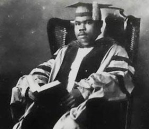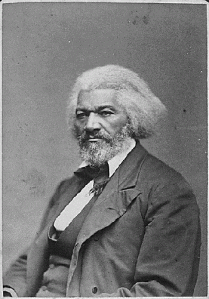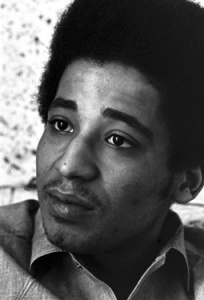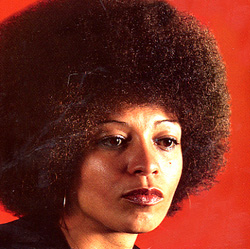THE CULTURE CORNER
________________________________________________________________
THE CULTURE CORNER ANTHEM THIS ISSUE
________________________________________________________________
“A people without the knowledge of their past history, origin and culture, is like a tree without roots.”
Marcus Mosiah Garvey (1887 – 1940)
Every year in October we celebrate BLACK HISTORY MONTH. Black history is with us every second, minute, hour, week, month and year. PANTHER NEWSLETTER’S CULTURE CORNER will attempt to enlighten you with what they never told you in your history class. Our story will be told right here – So enjoy the journey of clarification.
________________________________________________________________
Many people wonder why Republican legislators are so hard on President Obama. Frederick Douglass gave us the answer many years ago. Brothers all over the world who reside in a populace where they are the minority, will recognise and relate to his immortal statement.
“Though the colored man is no longer subject to barter and sale, he is surrounded by an adverse settlement which fetters all his movements. In his downward course he meets with no resistance, but his course upward is resented and resisted at every step of his progress. If he comes in ignorance, rags and wretchedness he conforms to the popular belief of his character, and in that character he is welcome; but if he shall come as a gentleman, a scholar and a statesman, he is hailed as a contradiction to the national faith concerning his race, and his coming is resented as impudence. In one case he may provoke contempt and derision, but in the other he is an affront to pride and provokes malice.”
Frederick Douglass – September 25, 1883
________________________________________________________________
Blacks in Britain (Part nine)
Not widely known – But true…
1951 – 1954 – Britain’s labour shortages increase the numbers of West Indian nursing and labour recruits from pre –1951 figures of less than 1,000 persons per year to 2,000 per year in 1952 and 1953, and 10,000 per year in 1954.
1951 – 1959 – Several remains of Roman-era (third-century AD) African soldiers were exhumed in an archeological dig at York in 1951. While the early 1950s saw increased demands in both British society and government for restrictions on black immigrants, also in 1951 the Society of Friends met at Toynbee Hall to discuss promoting racial harmony through increased welfare programs and changing the restriction policies used by British labour unions.
1952 – The Wales Establishment Office, responsible for providing British-owned ships with labourers, reported that black males could only find employment on foreign-owned ships, and that black women had been forced from jobs as domestics and shop girls, relegated to working for “mainly rag and bone merchants in the docklands area.” In a memorandum to the Trade Union Congress, written by the British Ministry of Labour Staff Association (a group which represented employment exchange workers), only half of the 152,000 job vacancies for that year would be open to black men. The reasons given reveal the depth of anti-black immigration sentiments voiced during the era: black males were to be barred from jobs where white women also worked; many employers objected to hiring blacks; the existence of job quotas; a perceived “lack of skill” among black workers; and other racist stereotypes.
1955 – 1962 – The number of West Indian nursing and labour migrants increased to an average of 32,850 per year.
1956 – As the need for workers fell, a substantial number of West Indian migrants returned home.
1958 – Racial clashes between whites and black West Indians occurred in August in Nottingham in the Midlands, and also at Notting Hill in London. The Conservative Macmillan government, strong on law and order, found any direct governmental response to the riots difficult, outside of supporting police, punishing offenders, and reassuring West Indian officials of their continued concerns. Civil liberty groups denounced the atmosphere of violence encountered by black people, “threatened to divide and disrupt the democratic life of this country.” Politicization of black immigration issues and the escalating violence against black people eventually aided Conservative restrictionists in their fight for immigration controls. By this year, the segregation of blacks into manual jobs had given these occupations the “taint” of racial inferiority. In a Ministry of Labour brief presented to the House of Commons, it was revealed that “white unemployed people are ‘not suitable for the kind of jobs held by the coloured people.’ “
1959 – Rumoured pending restrictions to immigration laws result in a dramatic increase in West Indian migration. The stabbing to death of Kelso Cochrane, a West Indian, by a white assailant, magnified concerns in the black community in Notting Hill that the police were still far from racially impartial. Although no police were at the scene when the crime was committed, “a police sergeant was authoritatively reported to have said ‘a nigger was stabbed to death by a white man.’ “
________________________________________________________________
FAMOUS BLACK PEOPLE PAST AND PRESENT
________________________________________________________________
George Jackson (Soledad Brother)
George Jackson was born in 1941. When he was eighteen Jackson was found guilty of stealing 70 dollars from a gas station and sentenced to “one year to life” in prison! – He spent seven and a half years in solitary confinement.
While in California’s Soledad Prison Jackson and W. L. Nolen, established a chapter of the Black Panthers. On 13th January 1970, Nolen and two other black prisoners were killed by a prison guard. A few days later the Monterey County Grand Jury ruled that the guard had committed “justifiable homicide.”
When a guard was later found murdered, Jackson and two other prisoners, John Cluchette and Fleeta Drumgo, were indicted for his murder. It was claimed that Jackson had sought revenge for the killing of his friend, W. L. Nolen.
On 7th August, 1970, George Jackson’s seventeen year old brother, Jonathan, single-handedly burst into San Rafael courthouse in Marin County with a satchel filled with handguns, an assault rifle and a machine-gun hidden under his raincoat. After taking Judge Harold Haley and four others hostage, he demanded: “FREE THE SOLEDAD BROTHERS!”, George Jackson, John Cluchette and Fleeta Drumgo to be released from prison. Jonathan Jackson was shot and killed while he was driving away from the courthouse.
Jackson published his book, Soledad Brother:Letters from Prison (1970). On 21st August, 1971, Jackson was gunned down in the prison yard at San Quentin. He was carrying a 9mm automatic pistol and officials argued he was trying to escape from prison. It was also claimed that the gun had been smuggled into the prison by Angela Davis. However, at her trial she was acquitted of all charges.
Read more about George Jackson; here…
________________________________________________________________
THE ANGOLA 3
During your festive celebrations when you will be enjoying your family, opening presents and saying prayers for peace, love and good will to all. Spare a thought and say a likkle prayer for the ‘Angola 3’. Who are they? – In 1972 three black men in a Louisiana prison were placed in solitary confinement after a prison guard was murdered. Two of them are still there – even though many believe they are innocent; read more about them here… and watch the brief film clip about the Angola 3 here…
________________________________________________________________
TRIBUTE TO OUR S/HEROES
Lena Doolin Mason (1864 – ?) was born in Quincy, Illinois. She attended High School in Hannibal, Missouri and later went to school in Chicago, Illinois. Around 1887, she entered into the ministry and was affliated with the Coloured Conference of the Methodist Church. She was a strong evangelist who travelled frequently though out the United States. She would preach to mainly white but later on to racially mixed congregations. She has two known surviving poems: ‘The Negro and Education’ and ‘ANegro In It’; read her poem ‘A Negro In It’ here…
Dr. Matilda Evans (May 13, 1872 – 1935) was the first African American woman licensed to practice medicine in South Carolina. She was born in 1872 to Anderson and Harriet Evans in Aiken, South Carolina, where she attended the Schofield Industrial School. Encouraged by Martha Schofield, the school’s founder, Evans enrolled in Oberlin College in Ohio, attended on scholarship for almost four years, and left before graduating, in 1891, to pursue a medical career. Evans’s survey of black school children’s health in Columbia, South Carolina, served as the basis for a permanent examination program within the South Carolina public school system. She also founded the Columbia Clinic Association, which provided health services and health education to families. She extended the program when she established the Negro Health Association of South Carolina, to educate families throughout the state on proper health care procedures; read more about her here…
Lovie Yancey (January 3, 1912 – January 26, 2008) was the American founder of the Fatburger restaurant chain. She originally owned a small restaurant in Tucson. In 1947 she founded Fatburger under its original name Mr. Fatburger. In 1952, Yancey shed both her business partners and the “Mr.” from the name of the hamburger stand, and Fatburger was officially born. Yancey sold her Fatburger company to an investment group in 1990 but retained control of the original property on Western Avenue. She established a $1.7-million endowment at City of Hope National Medical Center in Duarte in 1986 for research into sickle-cell anemia. This was in fulfillment of a promise to her 22-year-old grandson, Duran Farrell, who had died of the disease three years earlier; read more here…
Viola Davis Desmond (July 6, 1914 – February 7, 1965) was an African-Nova Scotian who bought her own beauty parlour and beauty college in Halifax. Desmond’s story was one of the most publicized incidents of racial discrimination in Nova Scotian and Canadian history. On November 8, 1946, Viola Desmond refused to sit in the balcony designated exclusively for blacks in the Roseland Theatre in New Glasgow but, instead, she took her seat on the ground floor where only white people were allowed to sit. After being forcibly removed from the theatre and arrested, Desmond was eventually found guilty of not paying the one-cent difference in tax on the balcony ticket from the main floor theatre ticket. She was fined$20 ($251.30 in 2010) and court costs ($6). She paid the fine but decided to fight the charge in court. After the trial, Desmond closed her business and then moved to Montreal where she could enroll in a business college. She eventually settled in New York where died on February 7, 1965 at the age of 50; read more about her here…
Bishop Samuel Ajayi Crowther (1809 – 31 December 1891) was the first black on record to be ordained as a Bishop of The United Church of Great Britain and Ireland. Born in Nigeria West Africa, Ajayi was an explorer and educator. He fought against the slave trade in his time. In 1838, he saw slavery and slave trading formally abolished.
Gordon Roger Alexander Buchanan Parks (November 30 1912 – March 7 2006) was a groundbreaking African American photographer, musician, poet, novelist, journalist, activist, and film director. He is best remembered for his photo essays for Life magazine and as the director of the 1971 film Shaft. At the age of 25, Parks was struck by photographs of migrant workers in a magazine and bought his first camera, a Voigtländer Brilliant, for $12.50 at a pawnshop. The photo clerks who developed Parks’ first roll of film, applauded his work and prompted him to get a fashion assignment at Frank Murphy’s women’s clothing store in St. Paul. Those photos caught the eye of Marva Louis, heavyweight boxing champion Joe Louis’ elegant wife. She encouraged Parks to move to Chicago in 1940, where he began a portrait business for society women; read more about him here…
Sir Abubakar Tafawa Balewa (December 1912 – January 15, 1966) was the first Prime Minister of Nigeria in 1960, the year it got its independence from Britain. Following the growing climate of political disruption in Nigeria, a coup was staged and Balewa died, believed to have suffered a heart attack after his arrest. He contributed to the fight for liberation of Nigeria.
Thelonious Sphere Monk (October 10, 1917 – February 17, 1982) was a noted Jazz pianist and composer. He was an innovative force in Jazz music in the 1940s. Born in North Carolina USA, his music in the ‘Swing’ era helped boost modern Jazz and his tunes include classics like ‘Round Midnight’ and ‘Straight No Chaser’.
Here ends your history lesson for this issue.
________________________________________________________________
I trust each and every one of you will enjoy your festive holidays, wherever you are. For those of you celebrating Kwanzaa; Happy Kwanzaa and I pray your affirmations of the Nguzo Saba, (The Seven Principles) guides you to a happy and prosperous New Year…
…And as it’s the season of Peace, Love and Goodwill to one and all, here’s a special treat. PANTHER NEWSLETTER proudly presents KOKUMO singing and strumming his tune ONE LOVE; here…
Jah Bless.
________________________________________________________________
Log on for more CULTURE CORNER in March 2012 and remember…
“Jails and prisons are designed to break human beings, to convert the population into specimens in a zoo – obedient to our keepers, but dangerous to each other.”
(Born January 26 1944)
Happy New Year!
‘Til March 2012 – Everyting – Bless
share this:
Related
This entry was posted on December 19, 2011 at 9:00 am and is filed under Articles, Black British Literature, Black History, News, Newsletter with tags Articles, Black British Literature, Black History, News, Newsletter. You can follow any responses to this entry through the RSS 2.0 feed. You can leave a response, or trackback from your own site.




Leave a comment